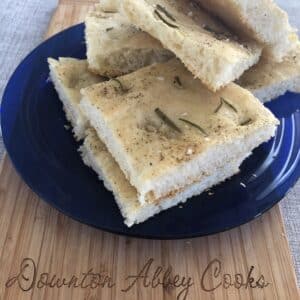 With its roughly dimpled surface and craggy interior, focaccia has become mainstream American, even appearing in some fast-food restaurants.
With its roughly dimpled surface and craggy interior, focaccia has become mainstream American, even appearing in some fast-food restaurants.
The Latin root of the word focaccia is ‘focus’ and refers to cooking by a fireplace or hearth. Literally a focal point for the family, a place where the dough was baked over hot stones, fire and she.
Interestingly, the flat bread of ancient Sicily was called ‘pitu’, a variant of the Greek ‘pita’ and more than likely the word which evolved into ‘pizza’. Various versions of this Italian bread can also be found in other parts of the world. In Burgundy, focaccia is called foisse or fouaisse, in other areas of France it is known as fougasse. In Argentina, it is widely consumed under the name fugazza. The Spanish call it hogaza.
While Americans may be used to soft, thick focaccia, this version comes from King Arthur Baking Company is closer to the classic Italian bread: a rustic, everyday loaf that’s usually a bit thinner than American-style.
Depending on how much olive oil you use, the size of your bake and how long you bake you can customize the recipe to be crusty and chewy, thin and crisp, or whatever style the family prefers.
My tip is to cut into larger pieces so you can easily them into toaster to rejuvenate the next day for a great snack.
Italian Style Focaccia
Equipment
Ingredients
Starter
- 1/2 cup cool water
- 1/16 tsp. instant yeast or active dry yeast
- 1 cup all-purpose flour
Dough
- all of the starter above
- 2 1/4 tsp. instant yeast or active dry yeast
- 1/2 cup lukewarm water
- 2 cups Unbleached All-Purpose Flour
- 1 1/4 tsp. salt
- 2 tbsp. olive oil
- Topping
- 2 tbsp. olive oil
- 1 tbsp. rosemary fresh or dried
- 1 tbsp. coarsely ground black pepper
- 1 pinch coarse salt or kosher salt
Instructions
Make the Starter
- Mix the water and 1/16 teaspoon yeast. Weigh your flour; or measure it by gently spooning it into a cup, then sweeping off any excess. Add the flour, stirring until the flour is incorporated. The starter will be paste-like; it won't form a ball.
- Cover and let rest at room temperature for about 14 hours; the starter will be bubbly. If you make this in the late afternoon, it'll be ready to go by the next morning.
Make the Dough
- Combine the overnight starter with the remaining dough ingredients, and mix and knead — by hand, mixer, or bread machine set on the dough cycle — to make a soft, smooth, elastic dough. If you're kneading in a stand mixer, it should take about 5 minutes at second speed.
- Place the dough in a lightly greased bowl, cover, and let it rise for 1 hour, or until it's noticeably puffy.
Stretch the Dough
- Use non-stick vegetable oil spray to lightly grease a large baking sheet (e.g., an 18" x 13" half-sheet pan). Drizzle about 2 tablespoons olive oil atop the spray; the spray keeps the bread from sticking, while the olive oil gives the bottom crust great crunch and flavor.
- Gently pull and shape the dough into a rough rectangle, and pat it into the pan. For thinner focaccia (1/2" to 3/4" thick), pat it all the way to the edges of the pan. For thicker focaccia (3/4" to 1" thick), don't pat all the way to the edges of the pan; leave an inch or so free around the perimeter.
- Cover the pan, and allow the dough to rise for 30 minutes. Use your fingers to make irregularly spaced dimples, pressing down firmly; your fingers should reach the bottom of the pan without actually breaking through the dough.

- Re-cover the dough, and let it rise until it's noticeably puffy, about 1 hour. The dough should have expanded, but shouldn't seem fragile, or look like it might collapse. Toward the end of the rising time, preheat the oven to 425°F. If you have a pizza stone or baking stone, set it on a middle or lower-middle rack.
- Spritz the focaccia heavily with warm water, and drizzle with 2 tablespoons olive oil (or enough to collect a bit in the dimples). Sprinkle with rosemary (or the herb of your choice), black pepper, and coarse salt, to taste.
Bake the Foccacia
- Place the pan of focaccia onto the baking stone, or onto a middle oven rack. Bake the focaccia until it's light golden brown, about 20 to 25 minutes. Remove the focaccia from the oven, and immediately turn it out of the pan onto a rack to cool.
- Slice into 16 slices. I find a pizza cutter makes quick work of the job. I like making larger slices for toppings, but also makes it easy to pop into the toaster the next day to quickly reheat.
Notes
-
The overnight starter does two things for your focaccia. First, it gives the yeast a chance to grow and really do its work, resulting in light-as-air flatbread with an appealing bit of chew. And second, as the yeast grows it releases organic acids and alcohol, both of which contribute immeasurably to the focaccia's flavour.
-
While often topped simply with herbs and sea salt, Italian focaccia also serves as a base for ingredients ranging from chopped olive, feta, and anchovies to sweet onions and capers. Use a light touch with any toppings; focaccia isn't pizza. But it's OK to be creative with these finishing touches.
- Want to make smaller focaccia? Try one of these options instead. Whatever size focaccia you choose, bake until it's light golden brown.
•Pat the dough into four 6" to 8" rounds, either freeform or in round cake pans.
•Make two 9" x 13" focaccia.
•For extra-thick (more American-style) focaccia, bake the full batch of dough in two 9” rounds or one 9” x 13” pan.
Nutrition

